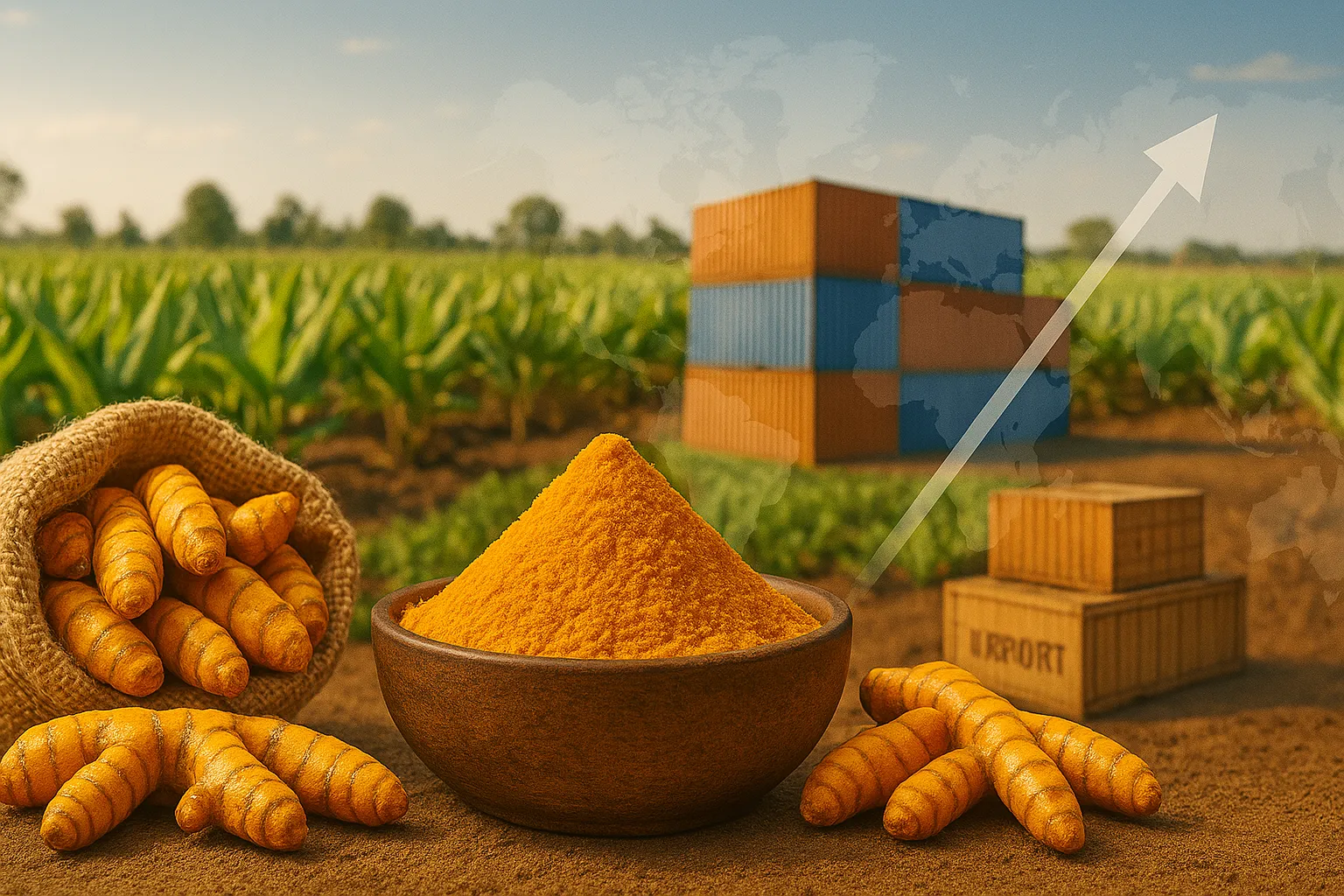Will India's Turmeric Skyrocketing Prices Reach to USD 1.92/kg – Global Demand Fuels Price Surge!
The global turmeric market in 2025 is witnessing dramatic shifts driven by production challenges, shifting export demand, and evolving market signals. In this comprehensive report, we delve into the latest news, global production status, exporter and importer profiles, product quality, harvest updates, and price forecasts. We also analyze market dynamics and offer insights into the factors influencing future price trends. Read on for an in‐depth analysis of the turmeric market from India, Vietnam, and beyond.
Latest Market Updates & Global Production Status
Market Developments and Price Trends
- Current Pricing:
Indian turmeric from the 2023 crop is trading at USD 1.66 per kg, while the 2024 crop is at USD 1.68 per kg. Traders are offering 2025 crop turmeric from Erode at USD 1.70 per kg (ex‐market) and expect prices to reach USD 1.78 per kg after adding freight costs. Recent market sentiment indicates that prices in India could touch USD 1.92 per kg in the near term, as low stock levels and rising export demand create upward pressure.
- Global FOB Price Perspective:
In addition to the US dollar pricing, some market sources suggest that global FOB prices may approach 1.70–1.80 €/kg in the coming months as new product arrivals slow down, reflecting a tightening supply situation.
- Price Fluctuations and Trade Sentiment:
The market has experienced significant volatility. For instance, on April 2, 2025, there were reports of turmeric prices in local markets nearing USD 1.92 per kg, driven by persistent low inventory levels and robust buying interest. Furthermore, technical trading in India shows that active stock management and bulk purchasing during minor price dips (around USD 0.06–0.08 per kg) are key strategies as traders brace for further price increases.

Global Production and Quality
- India’s Dominance:
India is the world’s largest producer of turmeric, contributing approximately 80% of global output with annual production around 1.1 million tonnes. Major production regions include Erode, Warangal, Nizamabad, Sangli, and Duggirala. Despite a 10% increase in the area under cultivation (rising to about 330,000 hectares), unpredictable weather and disease issues (such as crop rot and small rhizomes) have led to yield declines in regions like Nanded and Telangana.
- Quality Concerns:
The quality of turmeric is variable, with factors such as untimely rains and fungal diseases affecting curcumin content and overall pod quality. While Indian turmeric generally commands premium prices due to its high curcumin content, inconsistent quality in certain regions is a growing concern for both domestic and international buyers.
- Other Global Producers:
Vietnam, Peru, Costa Rica, Thailand, and Egypt are also notable players. Vietnamese turmeric, cultivated over 50,000 hectares across provinces like Quang Nam, Quang Ngai, Gia Lai, Kon Tum, Dak Lak, and Dak Nong, is highly valued for its vibrant color and pleasant aroma. Egyptian turmeric powder (99.9% purity) is also gaining traction in the global market, trading at FOB 2.50 €/kg—a 2.04% increase, showcasing its strong position in processed forms.
Export and Import Dynamics
India’s Export Market
- Export Volumes and Trends:
Despite challenges in production, Indian turmeric exports remain robust. Export data indicates that exports have grown, with a 13% year-on-year increase observed between April and December 2024. However, limited domestic stock and lower new arrivals are contributing to higher export prices.
- Major Importers:
Key importing countries of Indian turmeric include the United Arab Emirates, Saudi Arabia, the United Kingdom, Bahrain, and Oman. These markets, driven by high consumption of spices and natural wellness products, are critical for sustaining high export prices.
Vietnam’s Growing Export Presence
- Export Performance:
Vietnam’s turmeric exports have been on a strong upward trajectory. In the first two months of 2025, Vietnamese exporters earned USD 12.8 million on 5,949 tonnes of turmeric—a 31% increase in volume and around 70% in value compared to the same period in 2024. Vietnamese turmeric, prized for its high curcumin content (ranging between 3%–5%), is now a cost-competitive alternative, with prices ranging between USD 2.00 and 2.50 per kg.
- Market Share and Global Position:
With over 400 companies engaged in spice production and approximately 500,000 hectares under cultivation, Vietnam is rapidly expanding its global market share. Although India remains the dominant producer, Vietnam’s efficiency and competitive pricing are making it an increasingly attractive supplier in international markets.

Harvest Time & Quality
India’s Harvest Season
- Timing and Challenges:
In India, the harvest season for turmeric typically starts in late December and continues through March. However, this season has been marred by untimely rains and disease outbreaks, leading to variable quality and reduced yields in several key regions.
- Quality Variations:
Harvest quality in regions such as Nizamabad and Telangana has suffered, with lower yields (10–15% below expectations) impacting the overall supply. This reduction in quality is a significant factor in the rising market prices, as buyers seek premium, high-curcumin varieties.
Global Harvest Considerations
- Other Countries:
Countries like Vietnam, which benefits from favorable growing conditions in both coastal and highland areas, continue to produce high-quality turmeric consistently. In contrast, in Egypt, processed turmeric powder maintains high standards due to strict quality control measures during processing.

Prices Now and Future Trends
Current Price Levels
- Domestic and Export Prices:
Currently, Indian turmeric is trading at USD 1.66–1.68 per kg for the 2023–2024 crops, with forecasted prices for the 2025 crop around USD 1.70 per kg ex-market. Internationally, Vietnamese turmeric powder is available for USD 2.00–2.50 per kg, reflecting its competitive edge.
- Market Reaction:
The combination of low stock levels and reduced daily arrivals has led to bullish price trends, with market participants predicting a rise to USD 1.92 per kg in the near term.
Future Price Projections and Trends
- Supply-Demand Imbalance:
The persistent low inventory, with stock levels dropping from 1.2 million bags last year to 500,000 bags currently, coupled with decreasing daily arrivals (from 22,000–23,000 to 9,000–10,000 bags), indicates that the supply-demand imbalance is likely to push prices higher.
- Forecast Scenarios:
Analysts suggest that if demand continues to remain robust—especially during seasonal peaks like Ramadan—the global FOB prices may approach 1.70–1.80 €/kg, while domestic prices in India may further rise, reinforcing a bullish market sentiment.
- Export Influence:
The steady growth in export demand, particularly from key markets such as the UAE, Saudi Arabia, the UK, Bahrain, and Oman, is expected to support higher prices. Additionally, with Vietnam’s strong export performance, global competition is set to intensify, potentially leading to further price adjustments.

Factors Driving Price Increase
- Low Stock Levels:
A historic reduction in stock from 1.2 million bags last year to 500,000 bags this year has created a supply crunch.
- Reduced New Arrivals:
Daily arrivals in regions like Nizamabad have fallen from 22,000–23,000 bags to only 9,000–10,000 bags.
- Export Demand:
Strong export demand, particularly from countries like the UAE, Saudi Arabia, the UK, Bahrain, and Oman, is driving prices higher.
- Quality and Yield Issues:
In regions such as Erode, Warangal, and Telangana, poor yields and quality issues (e.g., due to small rhizomes and crop rots) are contributing to reduced supply and pushing market sentiment bullish.
- International Competition:
While Vietnam offers a lower-priced alternative with its high-quality turmeric, India still dominates with 80% of global production. The competitive pressure between these two major suppliers further drives market dynamics.
Market Analysis & Signals
Price Movements and Market Sentiment
- Futures and Spot Trends:
On the National Commodity and Derivatives Exchange, turmeric futures have surged by around 6%, settling at ₹14,918. This bullish trend is driven by lower-than-expected daily arrivals and strong buying interest, especially from key trading hubs like Nanded where yields are down 10–15% due to issues like small rhizomes and crop rot.
- Market Projections:
With export momentum and reduced supply, traders predict that prices could touch USD 1.92 per kg in the coming month. A break in the current trend could lead to further upward revisions if seasonal demand—particularly during festive periods like Ramadan—increases.
- Technical Indicators:
Technical analysis shows support levels around ₹14,354 with resistance at ₹15,198. Open interest trends indicate that traders are strategically buying during price dips, suggesting that the market is preparing for a recovery after the current downturn.
Export Market Insights
- Key Exporters and Importers:
- Exporting Countries: Major exporters over the last six months include India, Vietnam, Peru, Costa Rica, and Thailand.
- Importing Countries: Leading importers are the United Arab Emirates, Saudi Arabia, United Kingdom, Bahrain, and Oman.
- Trade Sentiment:
The rising export prices have been influenced by robust global demand and low carryover stocks. Buyers are willing to pay a premium for high-quality turmeric, while low-quality old stock and decreasing arrivals from major centers are further tightening the market.

Market Sentiment and Trading Strategies
- Stock Management:
With many traders clearing multi-year stockpiles and farmers holding back their produce in anticipation of better prices, market sentiment remains bullish.
- Technical Indicators:
Recent technical analysis shows support levels at around ₹14,354 and resistance at ₹15,198, indicating potential price fluctuations in the short term. Open interest trends suggest strategic accumulation during dips, hinting at further price recovery.
- Export Dynamics:
Despite some fluctuations, Indian exports have grown by 13% year-on-year between April and December 2024, while Vietnam’s export performance has significantly improved. These trends underscore the importance of export markets in maintaining price stability.
Additional & Complementary Updates
- Market Price Fluctuations and Future Projections:
- Reports indicate that on April 2, 2025, local transactions suggested turmeric prices in India might reach USD 1.92 per kg, supported by low inventory levels and strong export demand.
- Some analyses forecast that global FOB prices could edge closer to 1.70–1.80 €/kg if new product arrivals remain subdued.
- Production Challenges in Specific Regions:
- In areas like Nanded, yield reductions of 10–15% due to small rhizomes and crop rot have significantly tightened supply, reinforcing the upward price trend.
- The harvest season in India generally runs from late December through March, but this year’s unpredictable weather has led to variable quality and production challenges.
- Export Data and Global Trade Dynamics:
- Indian turmeric exports have experienced a 13% increase between April and December 2024, while imports in the same period surged by 84.35% year-on-year, although December saw a sharp decline (44.66% MoM) in imports.
- Major importing countries include the UAE, Saudi Arabia, the United Kingdom, Bahrain, and Oman, which continue to drive demand despite fluctuating domestic supplies.
- Competitive Landscape:
- While India dominates global production with 80% of the market share, competitors such as Vietnam, Peru, Costa Rica, and Egypt are also significant players. Vietnam, in particular, is capitalizing on its lower production costs and high-quality output.
- Egyptian turmeric powder, at 99.9% purity, is trading at FOB 2.50 €/kg, demonstrating robust performance in processed products.
- Policy and Trade Environment:
- The export dynamics of turmeric are influenced by global trade policies and market access. In particular, the relatively low import tariffs on turmeric in key markets like the UAE and Saudi Arabia are aiding Indian exporters.
- Government interventions and trade negotiations remain crucial, as any changes in import policies or quality standards in countries such as the EU, USA, and Middle Eastern nations could further affect the market.
- Supplementary Market Trends:
- There is a growing demand for turmeric in health and wellness products due to its high curcumin content and associated medicinal properties. This is expected to drive additional demand in North America and Europe.
- Technological innovations in post-harvest processing and quality control are critical for ensuring that Indian turmeric maintains its competitive edge in the global market.
Conclusion
The global turmeric market in 2025 is characterized by tightening supplies, robust export demand, and significant price surges. In India, production challenges—stemming from weather disruptions and disease—have led to lower stock levels and reduced daily arrivals, driving prices upward. Simultaneously, Vietnam’s competitive production, quality differentiation, and efficient export strategies are positioning it as a strong contender in the global spice trade.
Export demand from key markets such as the UAE, Saudi Arabia, the United Kingdom, Bahrain, and Oman continues to support high prices, even as India grapples with production challenges. The additional insights market reports further reinforce that quality issues, low inventory, and market policies are critical factors influencing the current and future price dynamics.
As the market evolves, traders and policymakers must closely monitor weather patterns, trade policies, and export-import dynamics. Strategic stock management, investment in quality improvements, and robust trade negotiations will be essential for sustaining growth and maintaining competitive market positions. Global shifts in demand, particularly in health and wellness sectors, signal continued opportunities for both Indian and Vietnamese turmeric producers.
FAQs
1. What are the current turmeric prices in India and how might they change?
- Currently, Indian turmeric from the 2023 crop is trading at USD 1.66 per kg, while the 2024 crop is at USD 1.68 per kg. Traders expect the 2025 crop to reach USD 1.70 per kg ex-market and potentially hit USD 1.92 per kg in the near term due to low stock levels and strong export demand.
2. Which countries are the major exporters and importers of turmeric?
- Exporters: India is the dominant exporter, contributing about 80% of global production, with significant exports also from Vietnam, Peru, Costa Rica, Thailand, and Egypt.
- Importers: Key importers include the UAE, Saudi Arabia, the United Kingdom, Bahrain, and Oman, alongside growing markets in North America and Europe.
3. What factors are driving the current price surge in turmeric?
- The price increase is primarily driven by reduced stock levels (from 1.2 million to 500,000 bags), a significant drop in daily arrivals, poor yields due to adverse weather and disease, and robust global export demand.
4. How is the quality of turmeric affected by current production challenges?
- Quality issues, such as reduced curcumin content and variable sensory properties, are emerging due to untimely rains and fungal diseases. Regions like Nanded report yield reductions of 10–15%, affecting overall product quality.
5. What are the future trends and market signals for turmeric prices?
- Analysts forecast that, if supply constraints persist, prices could rise further, potentially reaching USD 1.92 per kg. Market sentiment remains bullish, supported by strong export demand and reduced inventory levels.
6. How do global trade policies and tariffs affect the turmeric market?
- While turmeric is generally less affected by heavy tariffs, any changes in import policies or quality standards in key markets (e.g., the UAE, Saudi Arabia, the EU, and the USA) could influence market dynamics. Current favorable tariffs in the Middle East support Indian exports.
7. What insights from global Turmeric market reports should buyers know?
- Global FOB prices may approach 1.70–1.80 €/kg. Key export markets continue to drive demand despite lower stock levels. Technological improvements in post-harvest processing and expanded quality control measures are crucial for maintaining competitive advantage. Also, regions like Vietnam are capitalizing on their lower production costs and high-quality output to gain market share.









